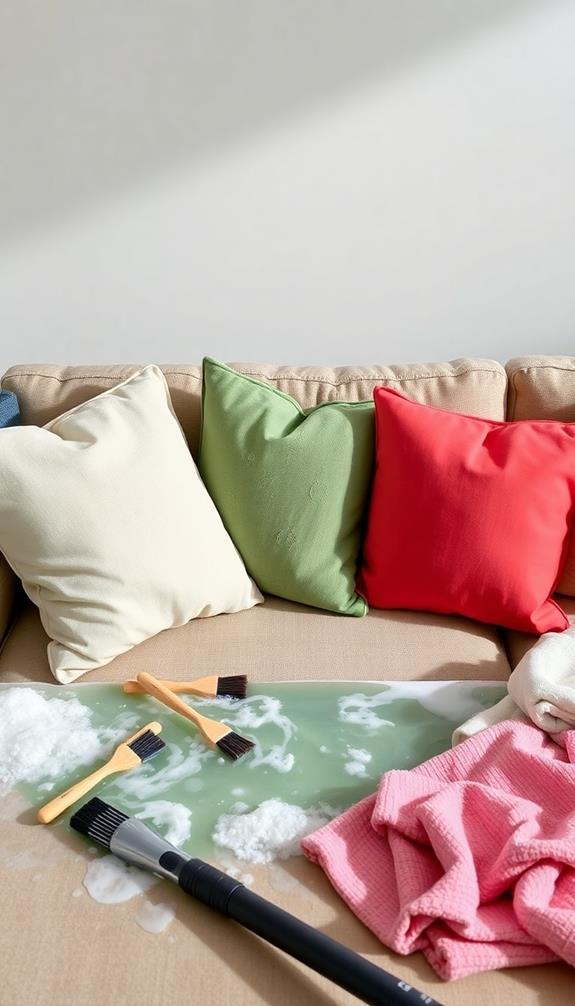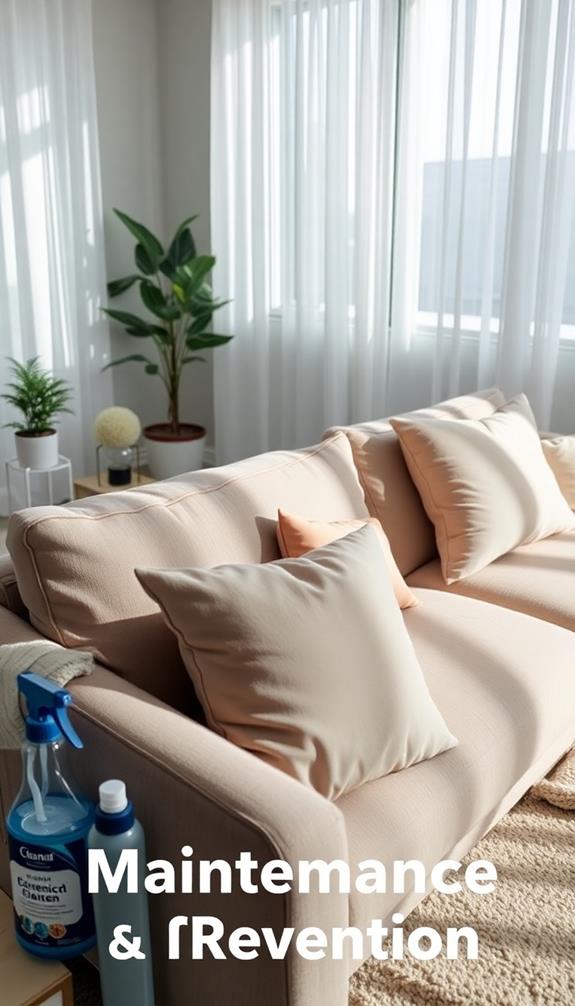To wash your couch cushions effectively, start by checking the care label for fabric specifics. For natural fibers, use gentle, water-based cleaners, while synthetic materials can handle solvent-based options. Remove cushions if possible; vacuum them first to tackle dirt and pet hair. For stains, combine diluted detergent with a microfiber cloth for spot treatment. If covers are removable, wash them on a delicate cycle. For non-removable cushions, use a cold water and detergent solution. Always air dry cushions completely to maintain their shape. Keep going to discover more tips for maintaining a fresh and clean sofa.
Importance of Cleaning Sofa Cushions
Cleaning your sofa cushions regularly is essential for maintaining a healthy living environment. Regular cleaning helps prevent dirt buildup, which can't only damage the fabric but also harbor allergens that affect your indoor air quality. By keeping your cushions clean, you contribute to better hygiene for everyone in your home.
Establishing a regular cleaning schedule can also help guarantee that your cushions stay fresh and free of dust and allergens. Deep cleaning your sofa cushions every six months is especially important if you have pets or children. This thorough approach guarantees that any spills or pet hair are promptly addressed, reducing the risk of permanent stains and damage to the fibers.
When it comes to non-removable covers, you may need to use specific cleaning methods to avoid damaging the fabric.
Don't underestimate the impact of clean sofa cushions on your living space's appearance. Fresh, clean cushions enhance your home's look while also improving the air quality by minimizing dust mites and allergens.
Making cleaning a priority not only prolongs the lifespan of your cushions but also creates a more inviting and healthier atmosphere for you and your family. So, take the time to clean your sofa cushions regularly—you'll notice the difference!
Identifying Fabric Types
Knowing how to identify the fabric type of your couch cushions is key to effective cleaning. Different fabric types require distinct cleaning methods, so understanding this will help prevent damage.
You'll want to check the manufacturer's care label for specific instructions, as this can save your cushions from irreversible harm. Additionally, proper identification aids in selecting suitable cleaning methods and helps prevent damage during cleaning.
Here's a quick guide to common fabric types:
- Natural Fibers: Silk, linen, and cotton often need gentle, water-based cleaners.
- Synthetic Materials: Vinyl, polyester, and microfiber can handle a variety of solvent-based cleaners.
- Specialty Materials: Suede and leather typically require professional cleaning due to their delicate nature.
- Fabric Care Codes: Familiarize yourself with codes like W (water), S (solvent), WS (both), and X (vacuum only) to choose appropriate cleaning methods.
If your couch cushions have removable covers, that's a plus! It makes cleaning easier.
Always remember, using the wrong cleaning method can damage your upholstered furniture. So, make sure you identify the fabric type correctly before you clean your couch, and you'll maintain its beauty for years to come.
For more details on cleaning techniques, check out this thorough guide.
Home Cleaning Methods

When it comes to keeping your couch cushions fresh and clean, incorporating regular home cleaning methods can make a noticeable difference.
Start by vacuuming your cushions using an upholstery brush attachment. This helps remove dirt, dust, and pet hair, preventing buildup and extending the life of your fabric. For non-removable cushions, use rubber gloves to gather hair and debris before vacuuming, and employ a crevice tool for seams and under cushions.
Regular maintenance, including vacuuming upholstered chairs weekly, can streamline the cleaning process.
If you notice stains, act quickly with a spot treatment solution. Mix a diluted detergent with water, and use a microfiber cloth to blot the stain—avoid scrubbing, as this can push the stain deeper.
For removable covers, always check the care label for washing instructions. Many covers are machine washable on a delicate cycle with cold water.
To maintain freshness, sprinkle baking soda on your cushions to absorb odors. Let it sit for about 30 minutes, then vacuum thoroughly.
Deep-Cleaning Techniques
Deep-cleaning your couch cushions can rejuvenate their appearance and extend their lifespan. Whether you have removable or non-removable cushions, the right techniques will guarantee they look their best. Here's a straightforward guide to get you started:
- Check Cleaning Codes: Always refer to the cleaning codes on your cushions' fabric. This prevents irreversible damage from using the wrong method.
- For Removable Cushions: Vacuum thoroughly to remove dust and debris, then wash the covers on a delicate cycle with cold water and a gentle detergent. Incorporating non-toxic cleaning solutions, such as natural ingredients and essential oils, can also help maintain a safe and healthy environment for your home.
- For Non-Removable Cushions: Fill a tub with a cold water and detergent solution. Submerge the cushions and use a pumping motion to lift dirt. Rinse thoroughly afterward.
- Tough Stains Treatment: For urine stains, rinse the area with water first, then treat it with a mixture of vinegar and detergent. Air dry to prevent shrinkage.
After deep cleaning, allow all cushions to air dry completely before reassembling them on the sofa. This helps maintain their shape and structure, guaranteeing your couch looks great for years to come!
Maintenance and Prevention Tips

Maintaining your couch cushions is vital to keep them looking fresh and extend their lifespan. Start with regular vacuuming at least once a week. This simple step helps prevent dirt buildup and keeps your cushions clean.
Consider applying a fabric protector; it creates a barrier against stains, making couch cleaning much easier when spills happen.
When spills occur, act quickly by blotting the area with a microfiber cloth. This technique can greatly reduce the risk of permanent stains setting in.
To guarantee your cushions wear evenly, rotate them periodically. This practice helps prevent uneven fading or compression over time.
Don't forget the importance of scheduling deep cleaning sessions every six months. This is especially important in homes with pets or children, as it contributes to a healthier living environment.
Conclusion
Regularly cleaning your couch cushions not only keeps your living space fresh but also extends the life of your furniture. Did you know that a study found that the average couch can harbor over 1.5 million bacteria per square inch? By identifying your fabric type and using the right cleaning methods, you can maintain a healthy environment. So, don't put it off—make cushion cleaning a part of your routine to enjoy a cleaner, more comfortable home!